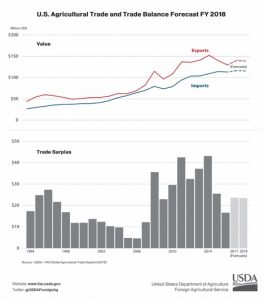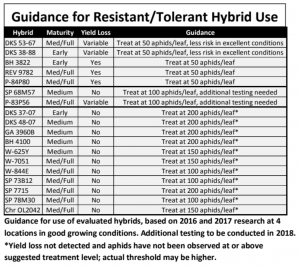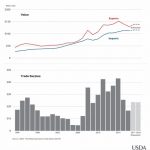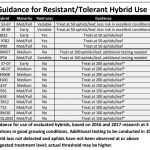NSP Update—National Sorghum Producers continued steps this week to respond to the announcement of anti-dumping and countervailing duties investigations into imports of U.S. sorghum by the Chinese government. Our partners and stakeholders across the industry are working closely together to demonstrate that U.S. sorghum is not dumped into China, it is not unfairly subsidized and is not injuring China.
Meanwhile, it is important our producers know trade with China and other countries continues. Last week’s export report shows exports remaining strong with China committing to purchase 4.6 million bushels of sorghum. Japan also committed to purchase 421,239 bushels to bring the weekly total to just under 5.0 million bushels. Total commitments for the marketing year now stand at 212 million bushels, including 204 million bushels of commitments from China. Shipments were also strong with China taking delivery of 4.8 million bushels and Japan taking delivery of 303,962 bushels shipped from the Pacific Northwest. Basis has recovered from recent shocks driven by trade concerns. Here are select basis bids from around the country:
- Ohio River: +20 for immediate delivery (compared to +6 for corn)
- Texas Gulf Coast vessel price: +165 for March delivery (compared to +63 for corn)
- West Texas and eastern New Mexico: -10 for new crop (compared to -10 for corn)
- Central Oklahoma: -30 for immediate delivery (compared to -35 for corn)
- Central Kansas: -50 for new crop (compared to -45 for corn)
- Central South Dakota: -30 for immediate delivery (compared to -60 for corn)
Trade Surplus—As our government and governments around the world debate the merits of global free trade, it’s important to keep in mind agriculture’s role in bolstering the United States’ trade balance. While every other American industry sector maintains a trade deficit with other countries – both in the North American bloc and around the world – agriculture consistently runs a trade surplus. This is a testament to the quality of American-produced crops and a reminder of the significance of keeping these international markets accessible. Below are two charts provided by the United States Department of Agriculture Foreign Agricultural Service. These charts demonstrate the net value of traded agricultural goods in the United States. Take particular note of the widening gap between export and import values over the last decade or so, which indicates that, when provided fair market access, our agricultural goods are as internationally competitive as ever.

Sugarcane Aphid Management on Tolerant Hybrids— Investigators: Michael Brewer, Research Entomologist (Corpus Christi area site, all sites coordination and principal investigator; mjbrewer@ag.tamu.edu); Robert Bowling, Extension Entomologist (Corpus Christi area site /outreach); Allen Knutson, Extension Entomologist (Hunt County coordination); John Gordy, County Extension Agent (Rosenberg area site); Danielle Sekula-Ortiz (Rio Grande Valley area site/outreach;
This research was funded by Texas Grain Sorghum Producers Board
Well timed application(s) of an insecticide can protect high yielding aphid susceptible hybrids from economically damaging populations of sugarcane aphid when using an economic threshold of 50-75 aphids per leaf. Essential in using this strategy is to scout fields for aphids on at least a weekly basis and spray within a few days of exceeding threshold. The scouting card and insecticide use guidelines produced with support from the Texas Grain Sorghum Board helps guide this effort.
For those considering growing commercial ‘tolerant’ or ‘resistant’ hybrids, current season-long research confirms that most but not all of these hybrids express partial protection of plants from sugarcane aphid. With results from 2016 and 2017, we provide guidance on SCA management for these hybrids, under the good growing conditions we experienced in the past two seasons. For some of these hybrids, aphids can be tolerated above the original ET (see Guidance column in table). Here, ‘resistant/tolerant’ hybrids maintained good yield despite aphid presence between 100 and 200 aphids per leaf. For other hybrids, yield loss was seen or variable, justifying continued use of an ET of 50 aphids/leaf. Note, these may be good performing hybrids when aphids are absent or controlled. We advise additional testing of some of these hybrids to verify this work under a range of growing conditions and locations. Those listed as ‘additional testing needed’ have not been confirmed to be highly resistant or tolerant and caution is advised until further testing.
Regarding insecticides, Sivanto Prime (Bayer) at 4.0 fl.oz./ac. or Transform (Dow) at 1.0 oz./ac. is recommended for treatment of SCA. Continued monitoring of SCA is recommended following insecticide application to verify control.

Changes in Base Acres—Part of the budget fix for cotton includes changes in base acres. Any generic base acres that have not been planted to a covered commodity, including program crops and cotton, from 2009-2016 become unassigned base acres making them ineligible for any Title I farm program payments. This will certainly raise additional base questions on expired CRP acres in the upcoming farm bill debate.
Plowing Through Food Facts—Texas Farm Bureau recently launched a new video campaign addressing misconceptions regarding agriculture. To see the video and webpage geared toward answering consumer questions, click here.










